Io – The Volcanic Moon of Jupiter

The image in which Linda Morabito first discovered active volcanism on Io in 1979. Credit:Voyager 1/JPL/NASA
In my previous article I presented how to see Jupiter’s moons and how I imaged them. In this article I examine in more detail Io, one of the more interesting Jovian moons.
Introduction
Of a list of the most unusual objects in the Solar System Io, Jupiter’s 3rd largest moon, must rate near the top of the list. When Voyager 1 sent back the first images of Io in 1979 they were stunned by what the saw. Heavily pocked marked with volcanic caldera’s, mountains and many different colors it was unlike anything seen before . No one expected active volcanism, but NASA JPL astronomer Linda Morabito was looking at images being returned from Voyager 1 and noticed what she thought was another partly obscured moon behind Io. But this was impossible and soon the team realized what they were observing was an immense plume of material erupting from the surface of Io. What she had discovered was an active extraterrestrial volcano!
Basic Data about Io

Io and it's orbit as rendered to scale in Celestia. Io is in the right hand corner, and the small moon Amalthea which orbits even closer to Jupiter is shown. Author:@terrylovejoy
Io orbits in a circular orbit 420,000 km from Jupiter, a distance very similar to the distance between us our own moon. It takes just 1.7 days to orbit Jupiter compared to 27 days for our moon. Orbiting further out are the moons Europa and Ganymede which have orbital periods of 3.6 days and 7.2 days, which are in exactly 2:1 ratio’s. It turns out the Io, Europa and Ganymede are in a 1:2:4 orbital resonance. This gravitational tug-a-war is believed to cause tidal heating of the Io and fuels the volcanism we see. The tidal forces also lock Io’s day into synchronization with its 1.7-day orbit, so that the same face of Io always faces Jupiter, much like the earth’s moon.
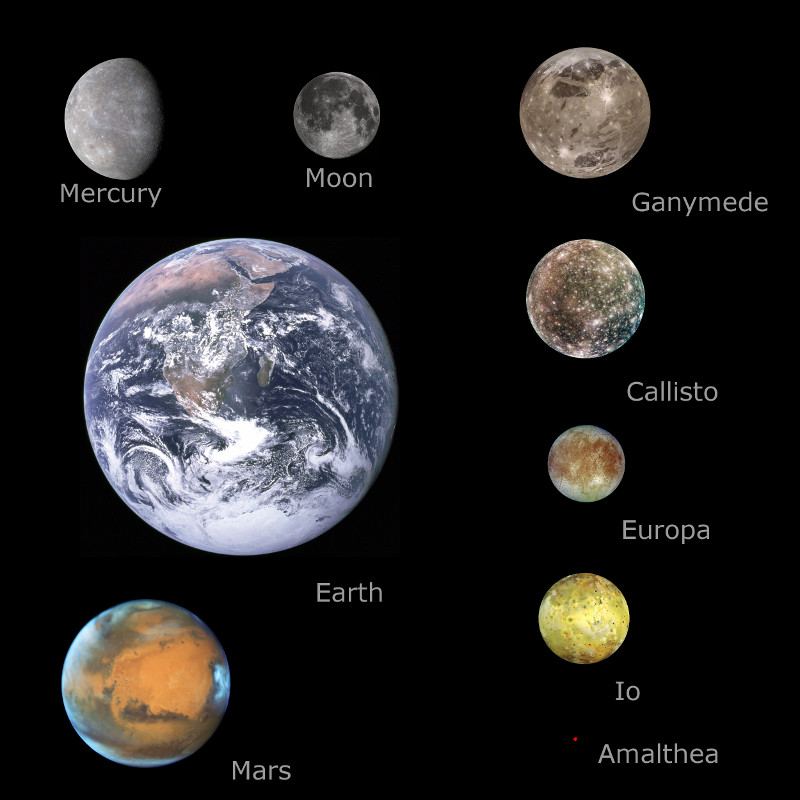
Relative sizes of Jupiter’s 4 largest moons, including Io. The relative sizes of the Earth, Mars and Mercury and the Earth’s moon are also shown. Credit:Author/NASA
At a diameter of 3660km, Io is slightly larger than earth’s moon, and it’s mean density of 3.5 kg/m3 is more comparable to the rocky inner planets than Jupiter’s other icier moons. It is also known to have an Iron / Iron Sulfide core.
An Overview of Io's Surface
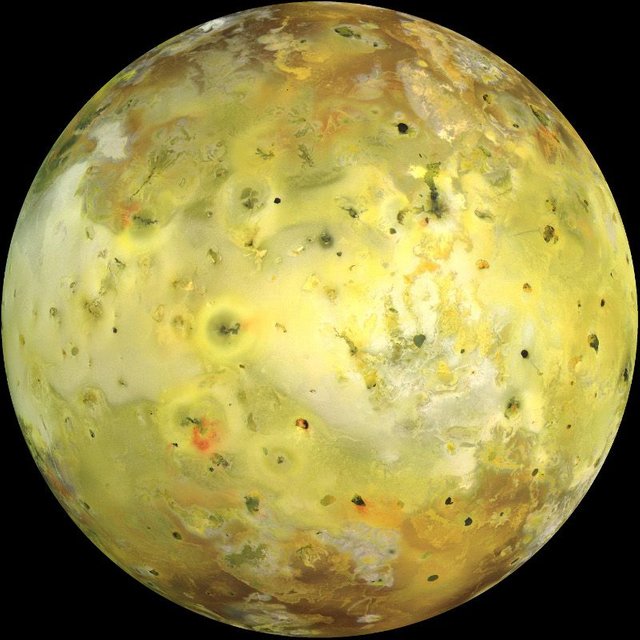
True Color image of Io by the Galileo Spacecraft. Please click image for fullsize version (highly recommended!) . Credit: Galileo/NASA
Since Voyager 1, Io has been extensively explored by other space missions including the Galileo mission. What they have found is quite an amazing variety of geological activity including extensive volcanism. We know it’s surface is very young and being recycled continuously because there is an almost complete absence of impact craters. Based on some estimates, material is deposited at a mean rate of 2m every 1000 years over the entire surface!
The surface of the moon is covered by different Allotropes of Sulfur as well as compounds such as Sulfur Dioxide, Sulfur compounds and some silicate materials. These give rise to the many different colors of the surface. Yellow Sulfur that we are familiar with on earth, assembles into a ring of 8 atoms, but on Io this form can be damaged by radiation to form red/brown forms of Sulfur. A large amount of the surface crust is also made of silicate rock and in some places, around the lava lakes, is hot enough to for silicate lava to exist.
Although Io’s gravity is too small to maintain anything but a trace atmosphere, Sulfur and Sulfur dioxide rain down over the surface from volcanic eruptions. Sulfur dioxide quickly solidifies to snow as the mean surface temperature is no more than 150K (-120 C).
Lava Lakes and Volcanism
From 1995-2003, the Galileo spacecraft, made passes of Io, that enabled it to make detailed observations of the volcanic region known as Tvashtar Paterae, revealing just how dynamic volcanism is on the moon. On its first pass in November 1999, enormous curtain of lava 25km and 1 km high could be seen erupting from one of its lava lakes. Temperature readings, based on IR observations indicated temperatures of 1500K, way above the boiling point of Sulfur (in a vacuum this is about 500K), and suggestive of silicate-based lava.

November 1999 image of Tvashtar Paterae showing the lava curtain. IR image has been overlayed and colored orange. Credit: Galileo/NASA
Only 3 month’s later, Galileo again observed Tvashtar Paterae, but the lava curtain eruption had shutdown. However, approximately 50km was a large hotspot. Here is the image from Galileo.
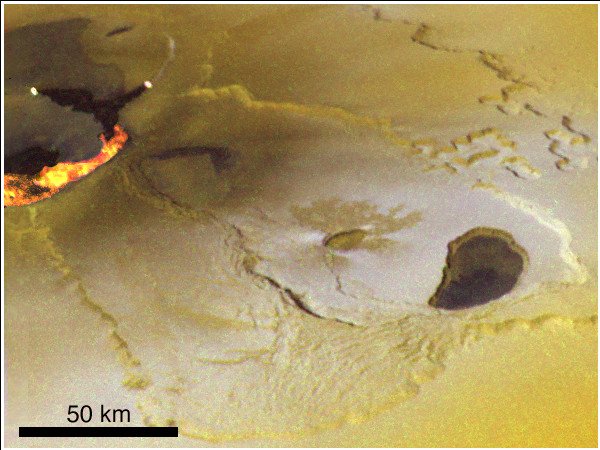
In December 2000, although thermal activity had largely subsided a large Sulfur plume eruption appeared centered over Tvashtar Paterae. Later in 2007 the new Horizon’s spacecraft captured this fine animation of the Tvashtar Paterae plume eruption on it’s way to Pluto.

Mountains

Haemus Mons, a 10-km high mountain is shown here. Interesting it appears to be covered in some type of snow (Sulphur Dioxide snow perhaps). Image Credit: Galileo/NASA
Perhaps somewhat surprising is that some of the largest mountains in the Solar system exist on Io. The highest, Boösaule Montes, towers a remarkable 17km above the surrounding plains with a steep side measuring nearly 15km high! How these form is still in debate, but probably are related to stresses cause by the rapid resurfacing of the moon’s crust.
Io and Jupiter's Magnetic field
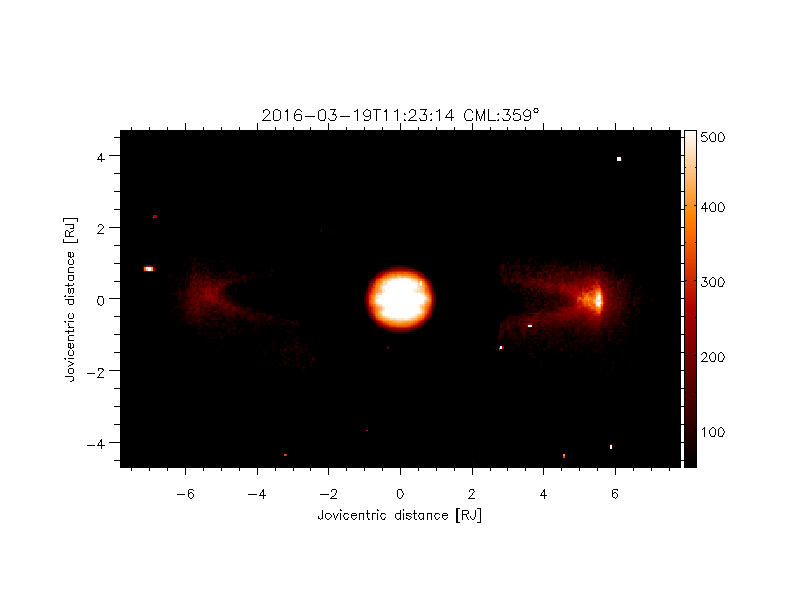
Sulphur emission observed in Io Torus, as observed by ground based observations in Hawaii. Image Credit: Dr. Masato Kagitani, The Planetary Plasma and Atmospheric Research Center (PPARC)
Io volcano’s supply up to a tonne per second of material to Jupiter’s magnetosphere in the form of Sulphur Dioxide which is ionized by solar radiation or impact by electrons from the magnetosphere. These ions form the Io plasma torus, which encircles Jupiter near Io’s orbit. This process is thought to help power the Jovian Aurora as well as Aurora on Io itself.
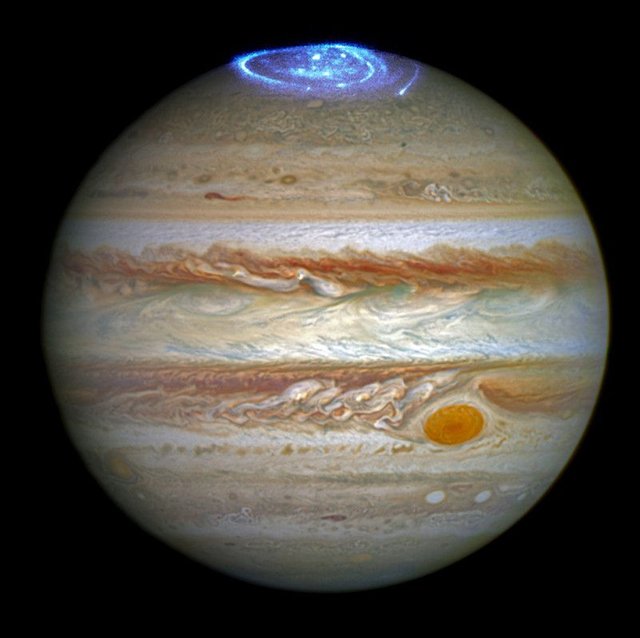
Jupiter Aurora. Credit: NASA, ESA, and J. Nichols (University of Leicester)
Conclusions
This is a brief introduction of the amazing world that is Io. Next time you get a chance to look at Jupiter through a telescope,check out Io which is usually visible as a small bright star next to the planet and imagine what an amazing place this is!
Further Reading/References
Morabito, L. A.; et al. (1979). "Discovery of currently active extraterrestrial volcanism". Science. 204 (4396): 972. Bibcode:1979Sci...204..972M
Peale, S. J.; et al. (1979). "Melting of Io by Tidal Dissipation". Science. 203 (4383): 892–894.
This is a test comment, notify @kryzsec on discord if there are any errors please.
Being A SteemStem Member
Io is truly a fascinating place. Those plumes seem large enough to engulf entire countries on Earth. I'd love to see a rover explore the surface of that place, but unfortunately from what I've read about the extremely high amounts of radiation there this wouldn't be very feasible.
Have you ever been able to see the yellow color stand out when observing Io in your telescope? I've seen it before along with the other moons but it just appeared as a star in plane with the other moons.
I plan to pay a bit more attention next time I put the scope on it. Apparently, when it goes into shadow behind Jupiter it develops a Sulfur Dioxide frost, so that when it reappears behind the shadow the moon looks brighter and whiter. I'd like to verify that sometime, its on my todo list!
Hi, I found some acronyms/abbreviations in this post. This is how they expand:
didn't know about that till now. Thanks 4 the info. :)